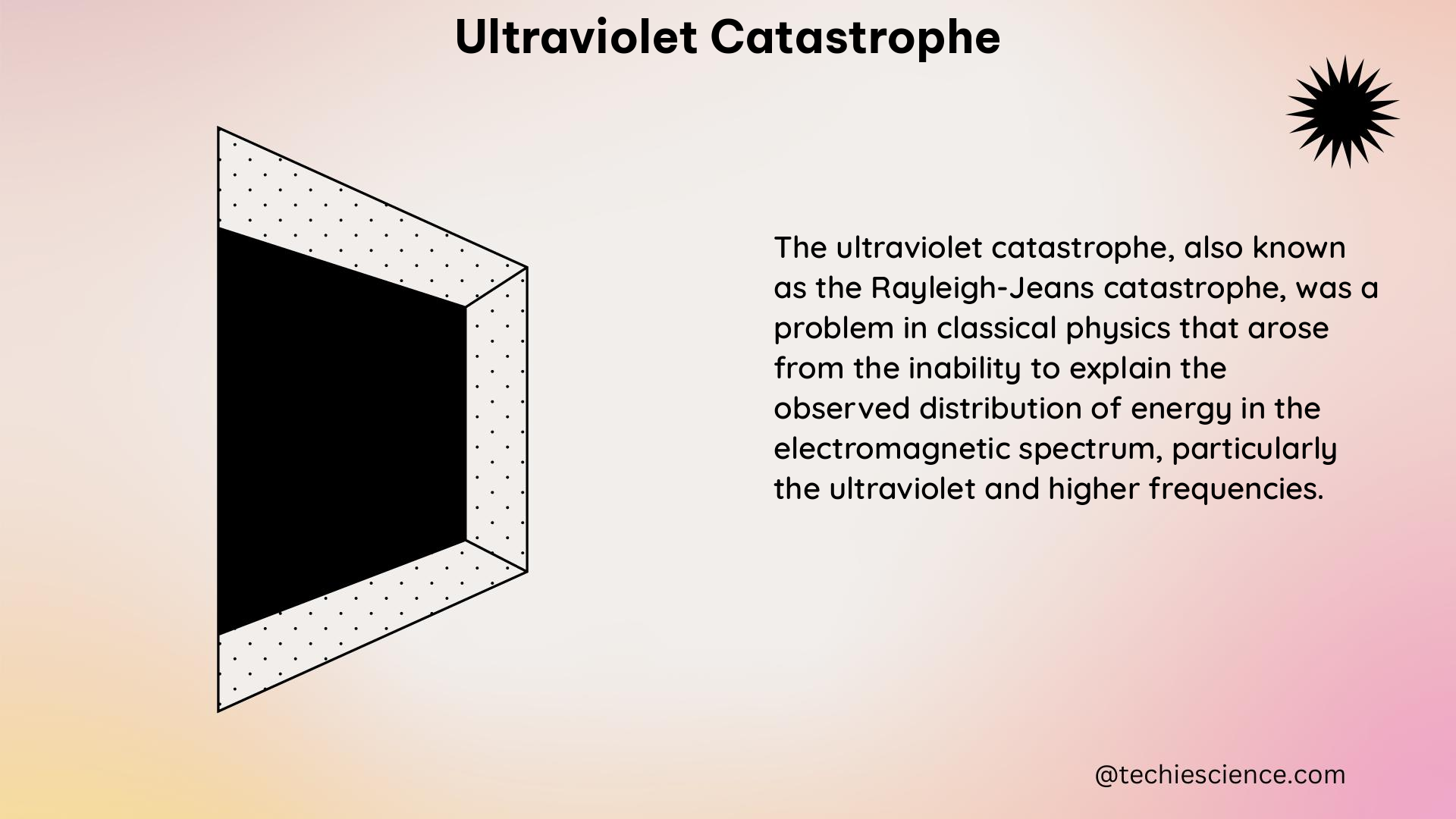The Ultraviolet Catastrophe is a pivotal concept in the history of physics that exposed the limitations of classical physics in accurately describing the energy distribution of blackbody radiation, particularly in the ultraviolet region of the electromagnetic spectrum. This issue was ultimately resolved by the groundbreaking work of Max Planck, who introduced the quantum theory in 1900, laying the foundation for the development of modern quantum mechanics.
Understanding Blackbody Radiation
A blackbody is an idealized object that absorbs all electromagnetic radiation that falls on it, regardless of the wavelength or angle of incidence. When a blackbody is heated, it emits thermal radiation, which is characterized by a specific energy distribution across the electromagnetic spectrum. This energy distribution is known as the blackbody radiation spectrum.
The key parameters that govern the blackbody radiation spectrum are:
-
Wavelength (λ): The wavelength of the emitted radiation, which is inversely proportional to the frequency (ν) of the radiation. Wavelength is typically measured in nanometers (nm) or micrometers (μm).
-
Intensity (I): The intensity of the emitted radiation, which is the power per unit area per unit frequency or wavelength. Intensity is usually measured in watts per square meter per hertz (W/m²/Hz) or watts per square meter per nanometer (W/m²/nm).
-
Temperature (T): The temperature of the blackbody, which is a critical parameter that determines the intensity and wavelength distribution of the emitted radiation. Temperature is measured in kelvins (K).
The Rayleigh-Jeans Law and the Ultraviolet Catastrophe

In the late 19th century, physicists attempted to develop a theoretical model that could accurately describe the blackbody radiation spectrum. The Rayleigh-Jeans law, proposed by Lord Rayleigh and James Jeans, was one such attempt. The Rayleigh-Jeans law is given by the following equation:
I(λ, T) = (8πc / λ^4) * (kB * T)
where:
– I(λ, T) is the intensity of the radiation at a given wavelength λ and temperature T
– c is the speed of light in a vacuum
– kB is the Boltzmann constant
The Rayleigh-Jeans law accurately described the blackbody radiation spectrum at longer wavelengths (lower frequencies), but it failed to predict the observed energy distribution at shorter wavelengths (higher frequencies), particularly in the ultraviolet region. This discrepancy between the theoretical predictions and experimental observations became known as the Ultraviolet Catastrophe.
The Ultraviolet Catastrophe was characterized by the divergence of the Rayleigh-Jeans law as the wavelength approached zero, leading to an infinite intensity value, which was clearly unphysical and contradicted experimental observations.
Planck’s Quantum Theory and the Resolution of the Ultraviolet Catastrophe
In 1900, Max Planck proposed a revolutionary solution to the Ultraviolet Catastrophe by introducing the concept of energy quantization. Planck’s key assumptions were:
- The energy of the harmonic oscillators in the blackbody is quantized and proportional to the frequency of the oscillation.
- The energy of each oscillator is given by the following equation:
E = n * h * ν
where:
– E is the energy of the oscillator
– n is an integer representing the energy level of the oscillator
– h is Planck’s constant, a fundamental constant in quantum mechanics
– ν is the frequency of the oscillation
Planck’s assumption of energy quantization led to the derivation of Planck’s blackbody radiation law, which accurately described the experimental data and resolved the Ultraviolet Catastrophe. Planck’s law is given by the following equation:
I(λ, T) = (2πhc^2 / λ^5) / (e^(hc / (λkBT)) - 1)
where:
– I(λ, T) is the intensity of the radiation at a given wavelength λ and temperature T
– h is Planck’s constant
– c is the speed of light in a vacuum
– kB is the Boltzmann constant
Planck’s blackbody radiation law not only resolved the Ultraviolet Catastrophe but also laid the foundation for the development of quantum mechanics, which would later revolutionize our understanding of the behavior of matter and energy at the atomic and subatomic scales.
Key Concepts and Formulas
- Wavelength (λ): The wavelength of the emitted radiation is inversely proportional to the frequency (ν) of the radiation, as given by the equation:
λ = c / ν
where c is the speed of light in a vacuum.
- Intensity (I): The intensity of the emitted radiation is the power per unit area per unit frequency or wavelength, as given by the Planck’s blackbody radiation law:
I(λ, T) = (2πhc^2 / λ^5) / (e^(hc / (λkBT)) - 1)
where h is Planck’s constant, c is the speed of light in a vacuum, and kB is the Boltzmann constant.
-
Temperature (T): The temperature of the blackbody is a critical parameter that determines the intensity and wavelength distribution of the emitted radiation. Temperature is measured in kelvins (K).
-
Planck’s Constant (h): Planck’s constant is a fundamental constant in quantum mechanics, which Planck introduced to resolve the Ultraviolet Catastrophe. The value of Planck’s constant is
6.62607015 × 10^-34joule-seconds (J·s). -
Speed of Light (c): The speed of light in a vacuum is a fundamental constant in physics and is used to calculate the frequency and wavelength of electromagnetic radiation. The value of the speed of light is
299792458meters per second (m/s). -
Boltzmann Constant (kB): The Boltzmann constant is a fundamental constant in statistical mechanics, which is used to relate the temperature of a system to the average energy of its constituent particles. The value of the Boltzmann constant is
1.380649 × 10^-23joules per kelvin (J/K).
Numerical Examples and Problems
- Example 1: Calculate the wavelength of the peak intensity in the blackbody radiation spectrum at a temperature of 5000 K. Use Wien’s displacement law, which states that the wavelength of the peak intensity is inversely proportional to the temperature:
λ_max = b / T
where b is Wien’s displacement constant, with a value of 2.897 × 10^-3 meter-kelvin (m·K).
Substituting the values, we get:
λ_max = (2.897 × 10^-3 m·K) / 5000 K = 579 nm
- Problem 1: A blackbody at a temperature of 3000 K emits radiation with a wavelength of 1000 nm. Calculate the intensity of the radiation at this wavelength and temperature using Planck’s blackbody radiation law.
Given:
– Temperature, T = 3000 K
– Wavelength, λ = 1000 nm = 1 × 10^-6 m
Using Planck’s blackbody radiation law:
I(λ, T) = (2πhc^2 / λ^5) / (e^(hc / (λkBT)) - 1)
Substituting the values:
I(1 × 10^-6 m, 3000 K) = (2π × 6.62607015 × 10^-34 J·s × (3 × 10^8 m/s)^2) / ((1 × 10^-6 m)^5) / (e^((6.62607015 × 10^-34 J·s × 3 × 10^8 m/s) / ((1 × 10^-6 m) × 1.380649 × 10^-23 J/K × 3000 K)) - 1)
Evaluating the expression, we get:
I(1 × 10^-6 m, 3000 K) = 5.67 × 10^4 W/m^2/nm
- Problem 2: A blackbody at a temperature of 2500 K emits radiation with a total power of 1000 watts. Calculate the total surface area of the blackbody.
Given:
– Temperature, T = 2500 K
– Total power emitted, P = 1000 W
Using the Stefan-Boltzmann law, which relates the total power emitted by a blackbody to its temperature and surface area:
P = σ * A * T^4
where σ is the Stefan-Boltzmann constant, with a value of 5.670374419 × 10^-8 W/m²/K⁴.
Rearranging the equation to solve for the surface area A:
A = P / (σ * T^4)
Substituting the values:
A = 1000 W / (5.670374419 × 10^-8 W/m²/K⁴ × (2500 K)^4)
A = 0.5656 m²
Therefore, the total surface area of the blackbody is approximately 0.5656 square meters.
Conclusion
The Ultraviolet Catastrophe was a pivotal moment in the history of physics, as it exposed the limitations of classical physics and paved the way for the development of quantum mechanics. Planck’s groundbreaking work in introducing the concept of energy quantization and deriving the blackbody radiation law not only resolved the Ultraviolet Catastrophe but also laid the foundation for our modern understanding of the behavior of matter and energy at the atomic and subatomic scales.
By understanding the key concepts, formulas, and numerical examples related to the Ultraviolet Catastrophe, students and researchers can gain a deeper appreciation for the historical significance of this event and the profound impact it had on the advancement of physics.
References
- Solving the Ultraviolet Catastrophe – Engineering LibreTexts: https://eng.libretexts.org/Bookshelves/Materials_Science/Supplemental_Modules_%28Materials_Science%29/Electronic_Properties/Solving_the_Ultraviolet_Catastrophe
- Packing of energy question related to the ultraviolet catastrophe – Physics Forums: https://www.physicsforums.com/threads/packing-of-energy-question-related-to-the-ultraviolet-catastrophe.997754/
- The Ultraviolet Catastrophe – Chemistry LibreTexts: https://chem.libretexts.org/Bookshelves/Physical_and_Theoretical_Chemistry_Textbook_Maps/The_Live_Textbook_of_Physical_Chemistry_%28Peverati%29/16:_The_Motivation_for_Quantum_Mechanics/16.03:_The_Ultraviolet_Catastrophe
- The Ultraviolet Myth – Hacker News: https://news.ycombinator.com/item?id=39345618
- Blackbody Radiation and the Ultraviolet Catastrophe – QSpace: https://qspace.library.queensu.ca/server/api/core/bitstreams/b1ee3a8e-d747-4290-9066-b606f056f886/content

Hi, I am Sanchari Chakraborty. I have done Master’s in Electronics.
I always like to explore new inventions in the field of Electronics.
I am an eager learner, currently invested in the field of Applied Optics and Photonics. I am also an active member of SPIE (International society for optics and photonics) and OSI(Optical Society of India). My articles are aimed at bringing quality science research topics to light in a simple yet informative way. Science has been evolving since time immemorial. So, I try my bit to tap into the evolution and present it to the readers.
Let’s connect through